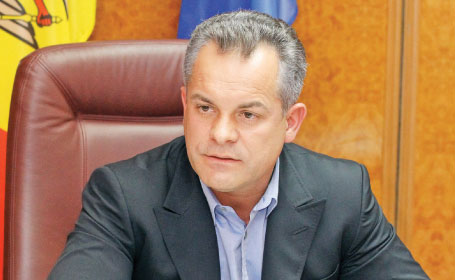
Sources of Moldova’s Political Chaos: The Party System and Coalition Rule
Publication: Eurasia Daily Monitor Volume: 10 Issue: 95
By:

The myth of Moldova as “the success story” in the European Union’s neighborhood, has clearly expired. Moldova’s institutions and rule of law have foundered in the chaos of its party system and rule by coalition—in this case, the internally conflicted Alliance for European Integration (AEI).
Both structural and circumstantial factors are responsible for Moldova’s political chaos. The existing party system with its direct product, the rule by coalition, are among the structural factors.
From a European policy perspective, Moldova’s technical and diplomatic work toward association, trade and visa-liberalization agreements with the EU can still be retrieved from the party-political chaos. That work has largely been accomplished by Vlad Filat’s Liberal-Democrat ministerial team (in office since 2010–2011 in this form). That work can still serve as a basis for inking those agreements with the EU at the Eastern Partnership summit scheduled for November in Vilnius, according to EU Enlargement and Neighborhood Policy Commissioner Stefan Fuele and other EU officials (rgnpress.ro, May 10; RFE/RL, May 15).
Liberal-Democrats headed the ministries most relevant to the ongoing stage of the Moldova-EU Action Plan (foreign affairs, internal affairs, justice, finance) and executed that plan. The Liberal Party of Mihai Ghimpu and the Democratic Party, led by businessman Vlad Plahotniuc and parliamentary chairman Marian Lupu (deposed in April 2013), were mainly preoccupied with dividing and re-dividing power and its spoils. They spent most of their energies within the AEI expanding their spheres of control at the Liberal-Democrats’ expense, particularly over law-enforcement and the judiciary. These leaders made no discernible contribution to Moldova’s European integration policy. It was simply not their first priority; and they actually hindered it when it contradicted their own interests.
Thus, on May 7, Lupu addressed an open letter to President Nicolae Timofti, strongly warning him against promulgating six laws adopted in parliament on May 3 (the seventh law, regarding the Constitutional Court, was returned by Timofti to the parliament for reconsideration). The May 3 laws revoked the sweeping concessions, squeezed from Filat by Plahotniuc on April 17–19. Lupu’s warning sought to intimidate Timofti into going along with Plahotniuc’s bid for de facto control of the state (Unimedia, May 7). If allowed to stand, this would have disqualified Moldova from association with the EU. In the event, Timofti promulgated four of the laws on May 9 and is considering the remaining two.
During the latest crisis, which broke out in January 2013 and brought down the AEI within four months, the Plahotniuc-Lupu tandem negotiated with Filat down to the wire, offering to tolerate a weakened Filat government, in return for concessions that would have led to Plahotniuc’s de facto hegemony in the state. By contrast, Ghimpu pressed for removing Filat’s team from the government as an unconditional, non-negotiable proposition. The closer Filat’s government drew to wrapping up the association and other agreements with the EU, the harder Ghimpu agitated to remove the government and prevent the Liberal-Democrats from capitalizing on this success in the next elections. Ghimpu’s relentless assault, combined with Plahotniuc’s quest for more power, forced the Liberal-Democrats into strategic deal-making with Plahotniuc or tactical deals with the Communists. The latter option turned out to be far less harmful than the former (see EDM, February 17, 18, April 25, May 9).
Ghimpu’s Liberals opposed EU integration goals on some major issues. Despite the party’s Liberal label and its Romanian nationalist credentials, it took the same the position as the Communists and the Russian Orthodox Church in Moldova, against non-discrimination legislation regarding homosexuals. The EU had imperatively demanded the adoption of that legislation, and Filat’s party took the political risk of pushing it through the parliament. Similarly, the de-monopolization and liberalization of Moldova’s civil aviation market, which the EU required, was opposed by Ghimpu’s Liberals, some of whose exponents in the transportation ministry were interested in preserving existing arrangements. The issue could only be resolved by transferring this dossier from the Liberal Party-controlled ministry to the prime minister’s chancellery. During the recent political crisis, Ghimpu declared that the EU-Moldova Deep and Comprehensive Free Trade Agreement (DCFTA, to be initialed at the Vilnius summit) went against Moldova’s national interests, and that his party would oppose the DCFTA. Ultimately, Ghimpu’s one-man show caused a part of the Liberal Party to split off and join forces with Filat’s Liberal-Democrats (Unimedia, April 21–22).
Founded in 2009, and renewed as AEI-2 in December 2010, this Alliance survived, at least formally, as long as it did thanks to EU insistence and a shared fear of the Communist Party. The AEI-2, however, gave an impetus to corruption and party-political control over state institutions that should have remained politically neutral. The tripartite coalition agreement, signed in December 2010, contained a secret annex, whereby the leaders agreed which party would control which state institutions, including law enforcement and parts of the judiciary. The secret annex leaked to the media in 2012. That distribution of posts turned out not to be definitive, but subject to re-negotiation down the road, with further destabilizing effects and Plahotniuc gaining the most from Filat under duress.
All this created a basis for subordinating government and law enforcement institutions to political parties, and indirectly to business interests associated with those parties. It also compromised the AEI government’s effectiveness. In practice, ministries often took orders from party leaders, sometimes overriding the prime minister or trumping the government’s jointly-agreed policies, and sometimes colluding with shadowy business.
The AEI had been doomed to dysfunctionality from the outset, for the simple reason that the three parties could only increase their respective share of votes at each other’s expense. Quite apart from group interests, these three parties are electoral rivals, competing against each other for overlapping segments of the electorate. On the “right wing,” Ghimpu’s Liberals can only break out of their traditional 10 percent voter share if they expand toward the center-right, by deeply biting off a portion of Filat’s electorate. On the “left-of-center” segment, the Plahotniuc-Lupu party has failed in its goal to encroach significantly on the Communist electorate, and can only grow toward the center at Filat’s party’s expense. This electoral imbroglio became a basis (along with more prosaic group interests) for the two lesser parties’ alliance against Filat’s larger Liberal-Democrat Party within the AEI.
Filat came to recognize that his participation in the December 2010 arrangement had been a blunder. It was a forced blunder, however. The billionaire Plahotniuc, a mysterious figure up to that point, supporting Lupu from the shadows, suddenly emerged into the public arena as a parliamentary deputy for Lupu’s Democratic Party. Following the November 2010 pre-term parliamentary elections, Lupu and Plahotniuc negotiated toward a coalition government with the Communist Party on one side and with Filat’s and Ghimpu’s parties on the other side, starting a bidding contest. The Democratic Party leaders squeezed major concessions from their AEI partners under the threat of forming a center-leftist coalition with the Communists.
Meanwhile, the Communist Party remains Moldova’s largest, and cannot be isolated without further polarizing and destabilizing the political system. Attempting to co-opt this party into the political system is an option that has yet to be explored.
More than two decades into independent statehood, Moldova has failed to develop a viable party system, let alone a viable model of coalition government. The existing party system and the rule by coalition have exacerbated dysfunctionality and corruption. Some building blocks for stabilization exist (see EDM, May 12), but any advance from chaos toward stability would necessitate that consideration be given to introducing changes to the political system. Successful reforms necessitate freeing the reformers in government from what has aptly been called “the coalition nightmare” in Europe’s East.




